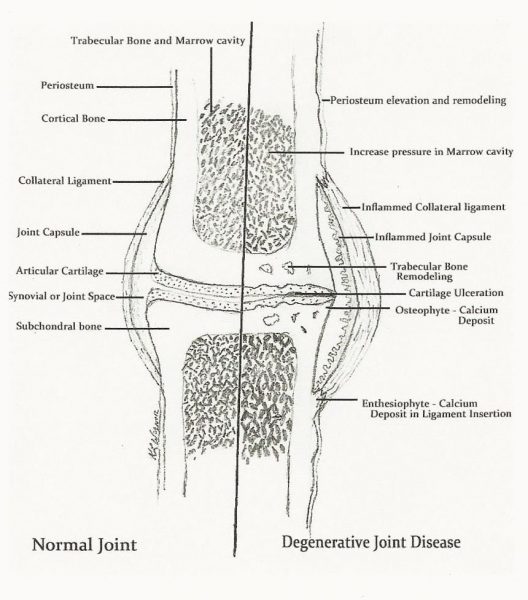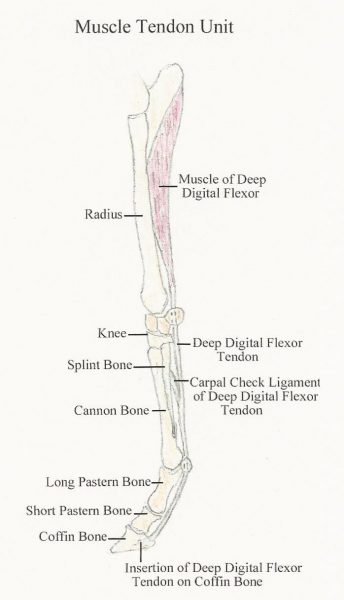Equine lameness is generally a failure of the musculoskeletal system of the horse. The cause of equine lameness generally falls in one of three categories: bone and/or joint conditions resulting from repetitive stress, soft tissue abnormalities or injuries, or blunt trauma. Since horses will be horses, putting bubble wrap on them in a padded stall is not an option, blunt trauma is unpredictable and unpreventable at best. However, the other two categories of equine lameness do have a preventative component to them.
One may say “sure how can you prevent a bowed tendon or a swollen joint”, or “the joints have to be injected to keep them sound, right?” No, these issues can be reduced or eliminated with proper care and soft tissue or joint issues can probably be prevented in a lot of cases. Understanding the normal bio-mechanical functions of the horse’s body will enlighten us on how we can prevent equine lameness. Previous blog posts in this series, Equine Bio-mechanics of Locomotion, Equine Gait Collection and Equine False Collection will help you understand normal and abnormal bio-mechanics of your horse. Each category of equine lameness will be discussed in regards to how it occurs.

Repetitive Stress Lameness
The first category previously mentioned was bone conditions or injuries resulting from repetitive stress. Examples of these types of injuries are fractures, arthritis or degenerative joint disease, navicular syndrome or calcium deposits.
Arthritis or Degenerative Joint Disease: A common injury everyone is familiar with or at least heard of is arthritis or degenerative joint disease (DJD). Arthritis is an acute or sudden change inflammation of the joint usually noticed initially as a warm swollen joint, whereas DJD is the chronic changing of an arthritic joint. As arthritis remains and becomes chronic, changes occur in the bone and soft tissue structures of the joint to classify it as DJD.
The progression occurs from a normal joint to an inflamed joint to a degenerative joint that the horse is trying to fuse. If fusion occurs there is no motion and no pain. The body has accomplished it’s goal of being non-painful but has lost some function in the process.
Repetitive stress injuries are described as repeating stress or micro-movement of the joint that produces inflammation in the joint. The micro-movement is a small shake, shimmy, or vibration in the joint motion beyond the normal joint motion. This abnormal micro-movement is joint instability. The instability or abnormal motion of the joint produces joint inflammation.
Signs of inflammation are swelling which is an increased amount of joint fluid and/or fluid around the joint, heat and a decreased range of motion. These joints are generally painful to some degree. As the reoccurring stress or micro-movement progresses, the body will attempt to stabilize the joint leading to DJD.
The progression of events toward DJD starts with joint instability initiating the acute changes of swelling and heat to cause a decrease in range of motion and joint stability. As the progression of inflammation and disease continues bio-chemical and structural changes occur in the joint fluid, cartilage, joint capsule and ligaments. The body attempts to stabilize the joint by increasing fibrous tissue in the structures around the joint, enzymatic degradation of the cartilage progressing to adhesion formation and by depositing calcium in the joint capsule, ligaments or para-articular structures to fuse the joint.
All of these body responses are an attempt to stabilize the joint and eliminate the pain. Traditional Veterinary Medicine would recommend reducing the inflammation in the equine joint by topical or oral anti-inflammatories like Surpass or Bute. Another method would be to inject the joint with a substance like a steroid, hyaluronan, or polysulfated glycosaminoglycan to reduce the inflammation. In more of a preventative line of thinking, Adequan or Legend is injected systemically or a joint supplement is given orally to prevent inflamed joints. Although these products can be effective in reducing equine joint inflammation and equine lameness, they do not correct the underlying cause of joint inflammation, joint instability.

Soft Tissue Lameness
Soft tissue injuries causing equine lameness generally take one of two courses. In regards to ligaments around the joints lameness is generally caused by the process previously explained. The unstable joint puts abnormal stress on the ligaments around the joint. This abnormal stress strains or tears the ligament creating pain, heat, and swelling in attempt to stabilize the joint.
In regards to other soft tissues like the flexor tendons or suspensory ligament on the back of the horses legs, the process of injury is a little different. These structures have a direct function with the muscle contracting unit and the stay apparatus. The muscle contracting unit consists of the insertion or attachment of the muscle to the bone at each end of the unit, a contracting muscle belly and tendon component.
In the leg of the horse the tendon component is a long section of the contracting unit which may run from the hoof to the forearm or gaskin area. When the tendon absorbs more stress then it is designed to because the muscle is not working properly, the tendon fibers may strain or tear creating a bowed tendon or suspensory ligament and a lameness. Also, the tendon may pull off of the bone causing an avulsion fracture at the attachment along with pain and lameness.
Blunt Trauma Lameness
The third cause of equine lameness is blunt trauma. Lameness by blunt trauma is generally a result of an incident due to the nature of the animal. Since they are a “Fight or Flight” type of animal; getting kicked, running into something, or falling down can be outcomes of their behavior and result in lameness. We have to rely on proper management and husbandry to eliminate some of these lameness issues. But some causes of equine lameness in this category may be influenced by our care.
Putting It All Together
Now that we have a general understanding and not a technical scientific understanding of lameness issues. Lets go back to our original question, can lameness be prevented? The first two categories of equine lameness have a higher frequency of prevention then the last; but, it is conceivable to reduce blunt trauma from a fall by stabilizing the animal.
A common thread in this discussion of the cause of lameness is the introduction of instability into the horse’s musculoskeletal system. This is because the joint becomes unstable or the tendon becomes over-stressed. Even the horse can become unstable and fall, producing blunt trauma with the ground. So where does the instability come from?
To answer that question we need to know what provides stability and normal bio-mechanical function. For normal bio-mechanical function look at Equine Bio-mechanics of Locomotion and Equine Gait Collection. The muscle is the predominate joint stabilizer providing about 80% of the joint’s stability. The stability of the tendon and ligament structures of the horse’s leg comes from the muscles in the muscle contracting unit. Stability of a horse results from the strength of the horse’s muscle units. Since the muscle is so important in each category of lameness, what is happening to the muscles to produce the changes in each category that results in pain and lameness?
Muscle Function
To understand the muscle function in stability, we need to discuss a little muscle physiology or function. The strength of the muscle is determined by the nerve impulse to the muscle. If the muscle is receiving 100% of it’s innervation or nerve pulse then it will produce 100% of its capable contraction otherwise known as strength.
Over time if the nerve impulse is decreased the size of the muscle will actually shrink. This shrinking process is called muscle atrophy. Some of you probably have seen horses or other animals with muscle groups that are much smaller in size when compared to the other side of the animal. Consequently, if the nerve impulse is not 100% then the strength of the muscle will not be 100% resulting in a week muscle in the horse. This is not a weak muscle that physical exercise or “pumping iron” is going to improve, however restoration of the nerve impulse to the muscle improves its strength.
What is not know is how much reduction in nerve impulse is required to produce a weak enough muscle to cause joint instability, ligament or tendon strain thus resulting in equine lameness. Is it a 1% or 5% reduction in nerve impulse or does it need to be 10 – 20% reduction? The amount of reduction is not known at this time.
When we improve the nerve impulse to the muscle, the muscle is no longer a weak muscle thus allowing muscle function to be restored. Therefore the joint, tendon and ligament will be stabilized. Consequently, the joint, tendon and ligament will work in a normal bio-mechanical fashion reducing joint instability which should prevent the above described lameness categories created by an unstable anatomical structure. This means equine lameness can be reduced and in some cases prevented.
How are the nerve impulses improved and therefore equine lameness prevented? By returning the vertebral joint function to normal, the edema or swelling is reduced around the spinal nerve root enabling the nerve to function 100%. The correction of the Central Pattern Generators of the spinal cord to correct weak muscles will enable improved nerve function and joint stability. Correcting the subconscious pain which has produced a protective stabilization of some bone with hypertonic or attenuated muscle function consequently changing the true biomechanical function of the horse.
Both abnormal vertebral joint function and Central Pattern Generator deficits are found and corrected with Applied Kinesiology and Chiropractic diagnosis and treatment. What is disheartening to some of my Traditional Western Veterinary colleagues is that the need for joint injections will be reduced or eliminated. If these four blog posts or others have created questions in your mind or if you don’t understand some of the concepts don’t hesitate to e-mail me.
